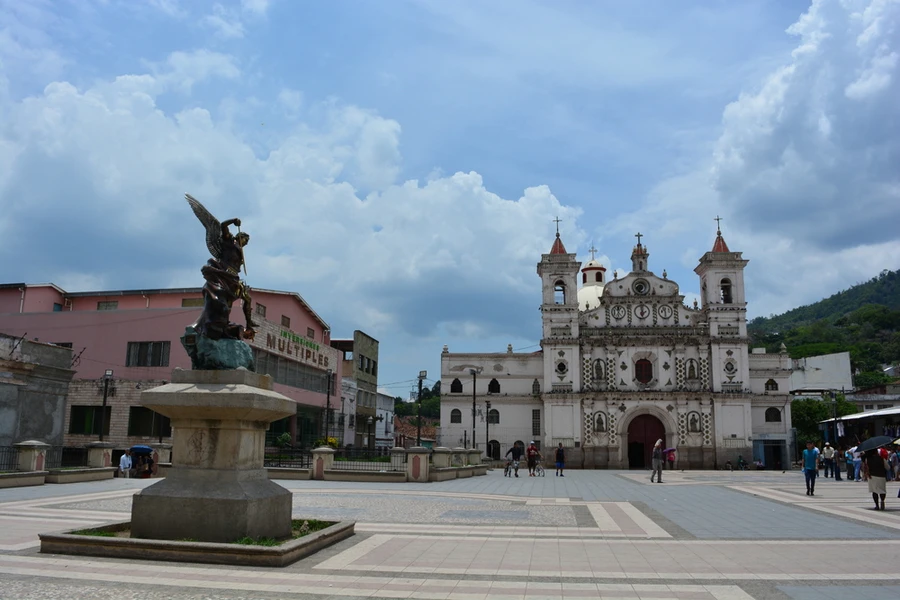
Washington D.C., Jul 20, 2018 / 06:00 pm (CNA).- The resignation of Bishop Juan José Pineda Fasquelle on Friday morning is the latest in a series of episcopal scandals breaking across the Church. He is accused of multiple counts of sexual and financial misconduct, and how his case is handled will be closely watched.
Pineda is alleged to have made repeated and unwanted sexual advances on seminarians. Other allegations include traveling on expensive holidays with “male companions” and even allowing a “companion” to reside in a purpose-built apartment using church resources. He is also accused of misappropriating more than $1 million in government funds intended for charitable projects.
As auxiliary bishop of the Honduran diocese of Tegucigalpa, Pineda was effectively in charge, acting in place of Cardinal Oscar Andrés Rodriguez Maradiaga. Cardinal Maradiaga, himself the subject of allegations of financial impropriety, has been largely absent from his diocese over the last five years while serving as the head of the C9 Council of Cardinals, appointed by Pope Francis to look at overhauling the governance of the universal Church. More recently, the cardinal has been receiving treatment for cancer.
Many of the allegations have been publicly circulating since December of last year and have apparently been common knowledge in the diocese for longer. In a statement, Pineda claims he submitted his resignation “several months ago.” But the timing of its acceptance by Pope Francis, and the renewed scrutiny it brings to Cardinal Maradiaga, arrives in the middle of an unfolding series of sexual abuse allegations against Cardinal Theodore McCarrick.
The still-breaking McCarrick scandal itself comes as Pope Francis struggles to resolve the national crisis of sexual abuse and cover-ups by Chilean bishops, five of whom have now left office.
Many had hoped that Church was seeing an end to the litany of sexual abuse scandals which rocked it during the first ten years of the millennium. Instead, there seems to be a new generation of scandals, in which abuse of adults, especially seminarians, and financial impropriety are the main offenses.
But perhaps the most important difference between today’s scandals and those of the early 2000s is that they concern bishops and cardinals, not priests. The differences between how these cases are handled, and their impact on the Church, is considerable.
Following the clerical abuse scandals of the previous decade, new and robust procedures were instituted in many places, especially the United States. Following the adoption of the Dallas Charter in 2002, and changes to canon law under Pope Benedict XVI, the procedures for dealing with an accusation against a priest were clear.
Today, if an allegation of abuse is made against a priest, diocesan authorities are usually swift to act, often suspending the priest from his parish and publicly announcing the nature of the allegations so that other potential victims can come forward. A formal investigation is held and, if it concerns a serious crime, the results are sent to Rome where it is determined how to proceed.
Yet no such procedure exists, at the practical level, for handling accusations against a bishop.
Victims, especially seminarians, with a complaint to make against a bishop have little reason to hope action will be taken. A disturbingly common thread running through recent allegations has been the extent to which abusive behavior was widely known but never acted on by Church authorities.
A chilling culture of silence regarding allegations of sexual misconduct in the Church has been exposed. In addition to the well-attested fear and shame felt by victims, both accusers and authorities who should have helped them often keep silent for fear of scandal. The hesitation to “hurt the Church” by making allegations public has led in many places to a culture of winking tolerance of sexual misconduct by senior clerics. By allowing more victims to be hurt in the meantime, this silence leads to the eventual scandal being all the more grave.
The lessons of recent history indicate that high profile media attention is the only guarantee of a serious response to an allegation against a bishop.
In 2013, Cardinal Keith O’Brien resigned as Archbishop of St. Andrews & Edinburgh following allegations that he made repeated sexual advances on clergy and seminarians in the archdiocese. The complaint was presented by three priests and a former priest. While the allegations were formally made to the Apostolic Nuncio in London, which appears to be the closest thing there is to an existing procedure in the Church, the speed with which he left office was widely credited to the men informing the nuncio of their intention to speak to the national press.
The allegations against Bishop Juan Barros, whose appointment to a small Chilean diocese marked the beginning of the crisis in that country, were known in Rome at the time of his appointment, and, as local outcry mounted, Cardinal Séan O’Malley is said to have personally delivered a letter from victims to the pope.
Yet it was only the backlash to Pope Francis’ apparent dismissal of the victims, despite their persistence and credibility, during a papal visit to Chile which finally prompted action.
In the case of Cardinal McCarrick, his predatory behavior towards seminarians was apparently legendary. But despite what everyone seems to have known, no formal action (apart from the out-of-court settlements) was ever taken by Church authorities until an allegation was made by a former altar server in New York.
In the case of Bishop Pineda, despite the seriousness of the allegations and the considerable local scandal, it seems it was only the publicity arising from his close association with Cardinal Maradiaga which prompted Vatican action.
Pineda’s resignation provokes a series of further questions which will test the Holy See’s resolve in seeing episcopal allegations through to the end.
Other prominent accused bishops, like Cardinal McCarrick, have been past, or near to retirement age. Given his advanced age and removal from public ministry, there is little to compel Vatican authorities to take further action. Indelicately put, it is not unknown for the Vatican to simply delay action against elderly bishops, counting on death to precede a process. This will not be an option with Pineda.
In a statement released on Friday, Pineda declared “I continue as a son of the Church; I continue forward as consecrated [a bishop]; I continue as minister of the Church; I continue forward at the disposition of my superiors.” Aged only 58, an indefinite hiatus from active ministry is not likely to be seen as workable solution. Rome will have to decide how to bring the allegations against him to a resolution, possibly through a canonical trial, and how to formally punish him if necessary.
What form such sanctions could take, and following what process, remains unclear.
Despite creating a new legal mechanism for canonical trials for bishops, officials in Rome have indicated that Pope Francis has reserved all abuse complaints against bishops to himself, personally. There is no obvious pattern for dealing with these cases to follow, and what results can be expected are hard to predict.
While there are understandable calls for abuser-clerics to be laicized, this very unlikely in the case of a bishop.
While laicization clearly expels a bishop from the hierarchy, it effectively ends any oversight church authorities have over him. Contrary to popular conception, a laicized bishop does not cease being a bishop, sacramentally speaking. Once conferred, sacraments like baptism, ordination, and episcopal consecration cannot be undone. If Pineda were laicized and he went on to seek ministry in unauthorized settings, sacraments he administered, including priestly ordinations, would still be valid. The potential damage and confusion which could be done by a rogue bishop, outside of church control, is enough to make laicization highly unlikely.
Bishop Emmanuel Milingo, for example stepped down from the leadership of a Zambian diocese in 1983, at the age of 53, after which time he illicitly but validly consecrated several married men as bishops. He was eventually laicized in 2009, but by that time he had been conducting unauthorized ministry for decades.
If the allegations against Pineda are proven, the most likely outcome is he would be removed from public ministry and assigned to live somewhere away from public view. There is some precedent for this course.
Perhaps the most likely example that could be followed is that of Kieran Conry, who was forced to resign as bishop of the English diocese of Arundel and Brighton at the age of 63 in 2013. Conry’s resignation was prompted by a string of inappropriate relationships with women, which were also common knowledge among the English hierarchy at the time of his appointment. Since then, he has been living in a church-owned house in southern England and out of public ministry. Cardinal O’Brien lived in similar conditions until his death in March of this year; while he resigned the “rights and privileges” of a cardinal, he was allowed to keep the title.
In the meantime, Pineda’s situation remains unclear.
There has been no formal announcement that he has been removed from public ministry – only his office as auxiliary of the diocese – and there has been no indication that he has left the diocese. How formally and transparently his situation is resolved will be telling.
Decisive and public action against Pineda seems called for, but it would set a standard against which other cases would be judged. It would also open the door to further questions about Cardinal Maradiaga’s complicity in, or at least awareness of Pineda’s actions.
Indeed, the great scandal, which remains unaddressed in all these cases – Pineda, McCarrick, Barros, O’Brien, Conry – is the extent to which other bishops were aware of the allegations against them and did nothing. Expressions of surprise, sorrow, and sympathy for the victims seem almost robotic at this point. Until such time as bishops who ignore misconduct among their peers are held to account for their effective complicity, there seems little hope that the cycle of scandals will be broken.
If you value the news and views Catholic World Report provides, please consider donating to support our efforts. Your contribution will help us continue to make CWR available to all readers worldwide for free, without a subscription. Thank you for your generosity!
Click here for more information on donating to CWR. Click here to sign up for our newsletter.




Sería interesante conocer cómo se llegó a tomar esta decisión; solo se conoció lo que informa el Nuncio en Honduras Novatus Rugambwa; enviando información calumniosas contra el Cardenal Rodríguez y el Obispo Auxiliar Pineda, deseaba destruir al Arzobispo y de esa manera detener la reforma de la curia Romana del Papa. El prefecto de Obispos de la Curia Romana recibió información calumniosa, sin pruebas y les da credibilidad. Delicado publicar sin fundamento!